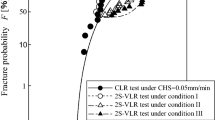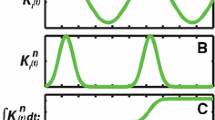Abstract
This paper aims to statistically estimate the dynamic fatigue strength in brittle materials under a wide range of stress rates. First, two probabilistic models were derived on the basis of the slow crack growth (SCG) concept in conjunction with two-parameter Weibull distribution. The first model, Model I, is a conventional probabilistic delayed-fracture model based on a concept wherein the length of the critical crack growth due to SCG is enough larger than the initial crack length. For the second model, Model II, a new probabilistic model is derived on the basis of a concept wherein the critical cracks have widely ranging lengths. Next, a four-point bending test using a wide range of stress rates was performed for soda glass and alumina ceramics. We constructed fracture probability–strength–time diagrams (F–S–T diagrams) with the experimental results of both materials using both models. The F–S–T diagrams described using Model II were in good agreement with plots of the fracture strength and the fracture time of both materials more so than Model I.











Similar content being viewed by others
References
Evans AG (1974) Int J Fract 10(2):251
Evans AG, Johnson H (1975) J Mater Sci 10:214. doi:https://doi.org/10.1007/BF00540345
Futakawa M, Kikuchi K, Tanabe Y, Muto Y (1997) J Eur Ceram Soc 17:1573
Barinov SM, Ivanov NV, Orlov SV, Shevchenko V (1998) Ceram Int 24:421
Pan LS, Matsuzawa M, Horibe S (1998) Mater Sci Eng A 244:199
Evans AG (1980) Int J Fract 16(6):485
Seshadri SG, Srinivasan M, Weber GE (1982) J Mater Sci 17:1297. doi:https://doi.org/10.1007/BF00752238
Guiu F, Reece MJ, Vaughan DAJ (1991) J Mater Sci 26:3275. doi:https://doi.org/10.1007/BF01124674
Tanaka T, Nakayama H, Okabe N, Imamichi T (1995) Strength and crack growth behavior of sintered silicon nitride in cyclic fatigue. Cyclic fatigue in ceramics. Elsevier Science, Japan, p II345
Ping Z, Zhongqin L, Guanlong C, Ikeda K (2004) Int J Fatigue 26:1109
Davidge RW, Mclaren JR, Tappin G (1973) J Mater Sci 8:1699. doi:https://doi.org/10.1007/BF00552179
Aoki S, Ohata I, Ohnabe H, Sakata M (1983) Int J Fract 21:285
Kokubo T, Ito S, Shigematsu M, Sakka S (1987) J Mater Sci 22:4067. doi:https://doi.org/10.1007/BF01133359
Okabe N, Ikeda T (1991) Mater Sci Eng A 143:11
Okabe N, Hirata H (1995) High temperature fatigue properties for some types of SiC and Si3N4. Cyclic fatigue in ceramics. Elsevier Science, Japan, p 245
Pfingsten T, Glien K (2006) J Eur Ceram Soc 26:3061
Evans AG, Fuller ER (1974) Metall Trans 5:27
Tokunaga H, Deng G, Ikeda K, Kaizu K (2005) Japan Soc Mech Eng A 71(712):1708
Author information
Authors and Affiliations
Corresponding author
Rights and permissions
About this article
Cite this article
Matsuda, S., Watanabe, R. Estimation of dynamic fatigue strengths in brittle materials under a wide range of stress rates. J Mater Sci 46, 5056–5063 (2011). https://doi.org/10.1007/s10853-011-5428-5
Received:
Accepted:
Published:
Issue Date:
DOI: https://doi.org/10.1007/s10853-011-5428-5




